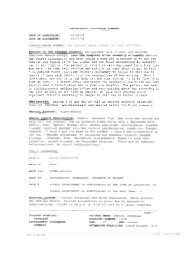C - Organized Mobbing
C - Organized Mobbing
C - Organized Mobbing
You also want an ePaper? Increase the reach of your titles
YUMPU automatically turns print PDFs into web optimized ePapers that Google loves.
At~enptlqg lo Know and Control tne oppos ol 497<br />
Vsing the sociology of understanding as a structuring device, I provide<br />
in what follows a quick surve!. over Stasi's measures of decomposition.^^<br />
I do so keeping in mind that in the following section I u7ill discuss the<br />
ficacy of these measures, which requires a theory of I I ~ I they ~ , have operated.<br />
It should also be kept in mind that measures of decomposition \\.ere often<br />
not applied singly, one after another. but in combination and over a lorger<br />
period oftime." Certain indi~iduals who were consistently identified b!. the<br />
Stasi as the leaders of PLT activities in Berlin-Mrolfgang Templin, one of<br />
the founding members of the IFM, is a good example and so is Rainer Eppelmann,<br />
pastor of the Church of the Samaritan-were subtected to a whole<br />
barrage of such measures (Pingel-Schliemann 2002, 294-300; Eppelmann<br />
1993, passim). Finally, it is important to keep in mind that not all men15ers<br />
of particular groups were treated uniformly."<br />
Among the tools of epistemic manipulation the easiest and most widely<br />
used strategy was to use the network of secret informants to recogni- ~e understandings<br />
selectivel~t to affect their acrualization in the desired direction.<br />
\%%ere informants li7ere unsuitable for such a task because the risks ofblowing<br />
their cover were deemed too high, anonymous letters or phone calls could<br />
be used. Here are some characteristic examples. Informants were, irony of<br />
ironies, under standing orders to raise security concerns among the activists,<br />
thus feeding other members' existing anxieties; they were asked to raise<br />
doubts about the group's ability to carry through a particular action, thus amplifying<br />
other activists' self-doubt, and all of that under the guise of care and<br />
thoughtfulness. The technique ofselective recognition was also used at larger<br />
open events taking place in lecture halls, churches, or performance venues<br />
to steer the atmosphere in a desired direction, for example, by cheering the<br />
contribution of more party-friendly speakers while meeting those of critics<br />
with icy reserve. For this purpose Stasi used "social forces" (ges~llschaftliche<br />
Kra3e), as this was far too risky a strategy for moles placed within the group. In<br />
30. To some degree I will list measures of the secret police, which the officers themselves would<br />
not have labeled "decomposition." Yet even in their own use the concept was blurry. Following<br />
thestasj's logic I will include in it all of their activities that intentionally interfered with activists'<br />
lives to end activities Stasi interpreted as PUT.<br />
31. For an overview covering cases of variants of decomposition from all over the GDR, see<br />
Pingel-Schliemann 2002.<br />
32. Although this may well have been intended in theory, the documents I have been able<br />
to consult do not suggest that this was a deliberately carried out strategy. Pingel-Schliemann<br />
(2002) argues that the level and intensity of means of decomposition unleashed against an<br />
individual were more dependent on the personal inclination of the individual case's leading<br />
officer and the willingness of superiors to support such measures. Based on my interviews and<br />
the cases I have studied in depth, 1 can only support this conclusion.<br />
---- ----------------- ----- - - - - ---- - - - - ---- ---- ----





